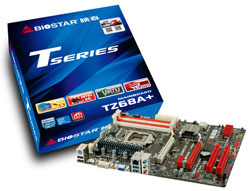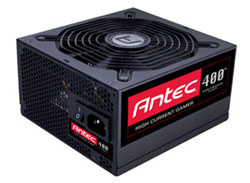Sandy Bridge Buyer’s Guide
by Zach Throckmorton on June 17, 2011 3:20 PM ESTThe $1000 Midrange Sandy Bridge Build
Our midrange build doubles the price; if that seems like a hefty price to pay we should note that it can also more than double performance. If all you’re doing is surfing the web, writing emails, and working with spreadsheets, no, you probably don’t need quad-core Sandy Bridge. If you happen to run more processor intensive workloads—or if you’d like to get an SSD into the mix—by all means go for it. Here are the specs of our midrange build.
| Midrange Core i5-2500K System | |||
| Part | Description | Price | Rebate |
| Processor | Intel Core i5-2500K | $216 | |
| Motherboard | Biostar TZ68A+ LGA 1155 | $118 | |
| Memory | Patriot 8GB (2x4GB) PSD38G1600K | $83 | -$20 |
| Graphics | ZOTAC ZT-40408-10P GeForce GTX 460 1GB GDDR5 | $150 | -$30 |
| Graphics Alternative | XFX HD-685X-ZNDC Radeon HD 6850 1GB GDDR5 | $180 | -$30 |
| Primary Storage | OCZ Vertex 2 OCZSSD2-2VTX60G 2.5" 60GB SSD | $120 | |
| Secondary Storage | Samsung SpinPoint F3 HD103SJ 1TB HDD | $60 | |
| Optical | LITE-ON iHAS124-04 DVD Burner | $25 | |
| Power Supply | Antec High Current Gamer Series HCG-400 PSU | $55 | -$15 |
| Case | Cooler Master HAF 912 RC-912-KKN1 | $60 | -$10 |
| OS | Microsoft Windows 7 Home Premium 64-bit | $100 | |
| System Total | $987 | $912 | |
Though the Intel Core i5-2500K is not Intel’s most powerful desktop CPU, it does best AMD’s flagship desktop processor, the Phenom II X6 1100T Black Edition. The Intel chip is not only more capable, but it also uses less power. To be blunt, the Core i5-2500K is mind-bogglingly fast for its cost. In my experience, the Core i5-2500K cuts through genomic datasets like a hot knife through butter, and it noticeably reduced the time it takes me to get answers to my research questions compared to the Phenom II X4 945 (C3) I was using previously. Video encoders and gamers alike will see remarkably improved results versus even the first-gen Core i5-750. Oh, and rare is the Core i5-2500K that can’t overclock to 4.4GHz on air, with the stock cooler.
So why go with the Core i5-2500K instead of the other Core i5 quads? Simple: you aren’t paying much more for the top of the line i5 part. The Core i5-2500K is only $40 more than the least expensive Core i5-2300, and that $40 gives you 300MHz more at stock (500MHz with Turbo Boost) as well as the ability to overclock with the unlocked multiplier. The other Core i5 chips are niche products, like the i5-2405S with its lower TDP and Intel HD 3000 graphics (vs. the Intel HD 2000 graphics on all of the other i5s sans the 2500K), or the i5-2400S, also with a lower 65W TDP. That said, if you have no intention of ever multiplier overclocking, the i5-2500 is essentially the same as the i5-2500K in its specifications (though the non-‘K’ version has Intel HD 2000 graphics instead of the HD 3000 graphics).
 As noted earlier, we recommend the Z68 chipset over P67-based motherboards now. The Biostar TZ68A+ offers tremendous value—it has all of the features expected from a Z68 board at a low price. I’ve had excellent first-hand experiences with Biostar’s T-series motherboards going back as far as the AMD Socket 939 days. Compared to other value Z68 boards, it has a three-year warranty (compared to, say, the ASRock Z68 PRO3’s one-year warranty). It also has fewer than normal rear USB 2.0 ports, but I don’t consider this too much of a negative. If two rear USB 2.0, two front USB 2.0, and two rear USB 3.0 ports (which are backward compatible with USB 2.0 devices) are not sufficient for your needs, you might consider spending more money on a more feature-rich board or buying a powered external USB hub.
As noted earlier, we recommend the Z68 chipset over P67-based motherboards now. The Biostar TZ68A+ offers tremendous value—it has all of the features expected from a Z68 board at a low price. I’ve had excellent first-hand experiences with Biostar’s T-series motherboards going back as far as the AMD Socket 939 days. Compared to other value Z68 boards, it has a three-year warranty (compared to, say, the ASRock Z68 PRO3’s one-year warranty). It also has fewer than normal rear USB 2.0 ports, but I don’t consider this too much of a negative. If two rear USB 2.0, two front USB 2.0, and two rear USB 3.0 ports (which are backward compatible with USB 2.0 devices) are not sufficient for your needs, you might consider spending more money on a more feature-rich board or buying a powered external USB hub.
We’ve upped the RAM to 8GB of DDR3. This is overkill for most users, but during intensive multitasking with demanding applications, the extra RAM can be useful. It might just be unpleasant memories of paying exorbitant sums for a mere 1GB of DDR back in the price fixing days coloring my judgment, but it’s hard to resist buying 8GB of DDR3 for less than $100!
We’ve included a SandForce-based 60GB OCZ Vertex 2 SSD for the OS and a few software titles as well as a fast 1TB mechanical hard drive for mass storage and extensive game libraries. 60GB isn’t particularly spacious, but at this system price point pairing a small SSD with a larger HDD provides a good balance of speed and storage space. (In other words, it’s hard to have both a larger, more expensive SSD and a large HDD without compromising, for example, the GPU.) We discussed which SSD would be best here, and we also eyed the Corsair Force F40 40GB and Kingston V100 64GB. Ultimately, we felt 40GB just wasn’t enough for our purposes, and $20 more could still fit into our budget. The Kingston V100 on the other hand provides an interesting option; it’s the same price initially, but there’s currently a $45 mail-in rebate. Yes, the SF-1200 controllers are faster overall (even with 25nm MLC NAND), but any decent SSD is still a big jump up from the best HDD.
For the video card, we had a bit of a debate on what would be best once again. This time, we decided to go with the green team, as the price difference (after rebate) is a pretty sizeable $30; however, it's such a close call that we're listing the Radeon HD 6850 as an alternative to the NVIDIA GTX 460 1GB, and both lines are packing some serious mail-in rebates right now. The two GPUs perform similarly, and while the Radeon HD 6850 has markedly lower power usage under load, they’re tied for idle power consumption. If you’re looking to buy DiRT 3, it’s probably the better card since you can get a free copy with the 6850 if you act fast. Ultimately, the GTX 460 1GB cards wins out with lower pricing, but note that if you go with the 400W PSU we list below you'll need to buy a Molex-to-PCIe power adapter. (You could save another $10 by going with the GTX 460 1GB SE; we initially had the EVGA card but ultimately felt the extra 17% compute power was worth $10.)
 To power everything, the Antec HCG-400 PSU is a very solidly constructed, less powerful version of the 520W we recently reviewed and praised. A 400W PSU is more than sufficient for this system, though I would not plan on adding a second GTX 460 later without a larger PSU! (If that’s your intention, we’d suggest starting with a 620W PSU instead.) If you feel 400W is too small for such a system, one of our editors (Jarred) is running an HD 5870 Toxic with an overclocked Bloomfield CPU and 24GB RAM off of a 450W PSU, and peaking at around 350W power draw from the wall (e.g. well under 300W load at the PSU), with idle power draw of only 170W (<150W from the PSU). This setup will certainly use less power than his system, making the HCG-400 more than sufficient, provided you're not going to add a second GPU or run half a dozen HDDs.
To power everything, the Antec HCG-400 PSU is a very solidly constructed, less powerful version of the 520W we recently reviewed and praised. A 400W PSU is more than sufficient for this system, though I would not plan on adding a second GTX 460 later without a larger PSU! (If that’s your intention, we’d suggest starting with a 620W PSU instead.) If you feel 400W is too small for such a system, one of our editors (Jarred) is running an HD 5870 Toxic with an overclocked Bloomfield CPU and 24GB RAM off of a 450W PSU, and peaking at around 350W power draw from the wall (e.g. well under 300W load at the PSU), with idle power draw of only 170W (<150W from the PSU). This setup will certainly use less power than his system, making the HCG-400 more than sufficient, provided you're not going to add a second GPU or run half a dozen HDDs.
Housing everything is a Cooler Master HAF 912 case. It’s broadly similar to the Antec Three Hundred in that it has mounts for two front 120mm intake fans (and comes with one installed), a rear 120mm exhaust fan (installed), and mounts for a side as well as top fan. Airflow/cooling is excellent, though again like the Antec Three Hundred, it’s not the quietest case. It’s also designed with water-cooling in mind, so if you ever want to water-cool your i5-2500K for aggressive overclocking, that will be straightforward.
All assembled, just under $1000 buys you a very solid all-around desktop computer that’s also able to handle current games at high resolutions and settings without risking a brownout while your air conditioning is on this summer. And if you’re diligent about sending in all those mail-in rebates, you’re looking at $907 for a new PC—including shipping (but not taxes).










90 Comments
View All Comments
gregounech - Friday, June 17, 2011 - link
FIRST YAY.DigitalFreak - Friday, June 17, 2011 - link
Morondavegraham - Friday, June 17, 2011 - link
is something missing here?meth0s - Friday, June 17, 2011 - link
Maybe this went up a bit early ;-)ImSpartacus - Friday, June 17, 2011 - link
Hey, I'll give you props for trying. Can't get it right every time.ImSpartacus - Friday, June 17, 2011 - link
Oh, I get it. This is the blip for RSS feeds.Can't wait for the rest of it!
JarredWalton - Friday, June 17, 2011 - link
Whoa! Not sure what happened there, but I was still editing the article and putting it into the CMS when you guys started looking at it. LOL. It's now finished so read at your leisure.davegraham - Friday, June 17, 2011 - link
lol...no prob, Jarred.Zink - Friday, June 17, 2011 - link
You should scale the cases so readers can see how much bigger than a 300 the 800D is.marc1000 - Friday, June 17, 2011 - link
yes, the size of the case is important too. I quit buyn a HAF912 because it won't fit in my desk. I will have to change the desk first! :(